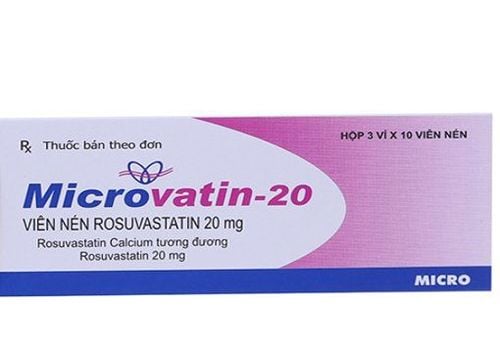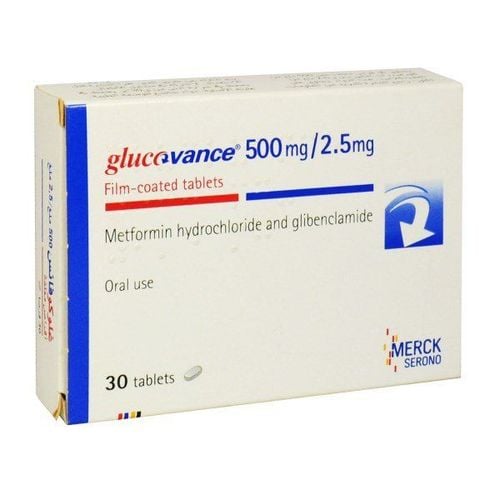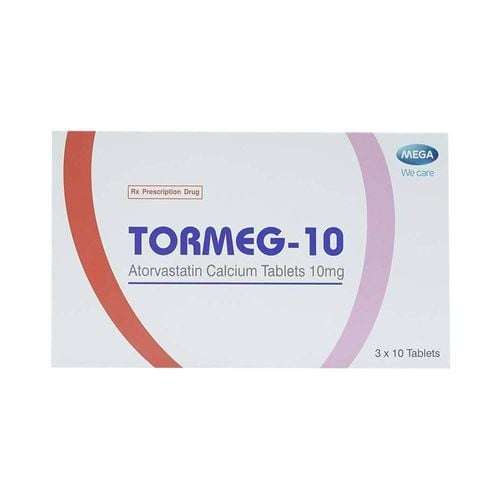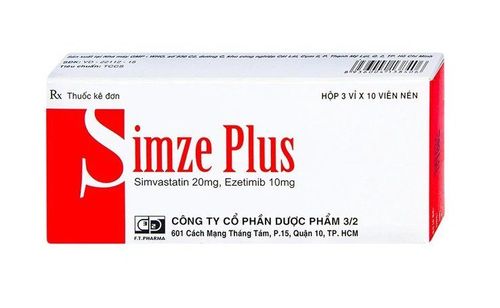This is an automatically translated article.
Statin drugs such as Atorvastatin are used relatively commonly with effectiveness in lowering blood lipids and preventing cardiovascular events. One product with the active ingredient Atorvastatin is Rotacor 10mg and Rotacor 20mg.
1. What is Rotacor 10mg?
Rotacor has the main active ingredient is Atorvastatin with the strength of 10mg or 20mg. Rotacor 10mg and Rotacor 20mg in combination with appropriate nutrition will support the treatment of hypercholesterolemia, hypertriglyceridemia or mixed hyperlipidemia.
2. Uses of the drug Rotacor
Rotacor 10mg or 20mg is indicated for the treatment of lowering total cholesterol, LDL-C and blood triglycerides, and supporting the increase of HDL-C in cases of primary hypercholesterolemia (heterozygous and non-familial) familial).
Rotacor is also indicated to support the reduction of total cholesterol and LDL-C in patients with homozygous familial hypercholesterolemia.
Rotacor 10mg is indicated for the prevention of cardiovascular complications:
For cases where there is no obvious clinical manifestation of cardiovascular disease, with or without dyslipidemia but with some risk factors for the disease. coronary heart disease (CHD) such as smoking, hypertension, diabetes mellitus, low HDL-C levels or family history of early coronary artery disease, Rotacor is indicated for the following purposes: To reduce the risk of death due to coronary artery disease and myocardial infarction ; Reduce the risk of stroke; Reduce the risk of restenosis after revascularization; Reduce the risk and frequency of angina attacks. In patients with obvious coronary artery disease, Rotacor is used for the following purposes: Reducing the risk of myocardial infarction; Reduce the risk of stroke; Reduce the risk of coronary revascularization intervention; Reduced risk of hospitalization for congestive heart failure (CHF); Reducing the risk of angina In children aged 10 to 17 years, Rotacor 20mg is indicated for the reduction of total cholesterol, LDL-C and apoB levels in premenstrual boys and girls with hypercholesterolaemia. heterozygous familial blood, unresponsive to diet and accompanied by the following:
Blood LDL-C level remains above 190 mg/dL or; LDL-C level remains above 160 mg/dL and; Family history of early cardiovascular disease or; Have at least 2 cardiovascular risk factors.
3. Instructions for using the drug Rotacor
Rotacor 10mg and 20mg drugs are used orally only once a day at any time, possibly before or after meals.
Before and during treatment with Rotacor, patients should take measures to control hypercholesterolemia such as proper nutrition, exercise, weight loss if obese, and treatment of comorbidities.
Dosage of Rotacor every day from 10 to 80 mg. Initial and maintenance doses will be individualized, depending on blood LDL-C levels, treatment goals, and patient tolerability. After using the starting dose of Rotacor 2 to 4 weeks, the patient needs to have blood lipids tested to adjust the 4 doses accordingly.
Dosage of Rotacor in the treatment of primary hypercholesterolemia and mixed hyperlipidemia:
Most patients will be controlled stably at 10mg/day; Response to treatment is markedly after 2 weeks of taking Rotacor, maximum effect is achieved within 4 weeks and can be maintained for a long time. Rotacor dose for heterozygous familial hypercholesterolemia:
Start with 10mg/day, individualized and adjusted every 4 weeks up to 40mg/day; The maximum dose can be up to 80mg/day or in combination with a bile acid separator at a dose of 40mg/day. Rotacor dose to treat homozygous familial hypercholesterolemia:
Currently, there are not many research data in this case; The dose of Rotacor varies from 10 mg to 80 mg/day and should be considered as an adjunct to other lipid-lowering measures (such as LDL dialysis) or when no other treatment is available. Dosage of Rotacor for the prevention of cardiovascular events:
Initial dose is 10 mg/day, the dose can be increased to achieve LDL-C concentrations according to current guidelines. Patients with renal impairment:
No dose adjustment of Rotacor is required for patients with renal impairment; Patients with hepatic impairment:
Care should be taken when using Rotacor in patients with hepatic impairment; Use of this product is contraindicated in patients with advanced liver disease. Elderly patients:
The safety and efficacy of Rotacor in patients 70 years of age and older at recommended doses is similar to that of the general population. Pediatric patients:
Children over 10 years of age experiencing familial hypercholesterolemia use the initial dose of Rotacor 10mg/day, then adjust according to the patient's response. Diabetes:
Some studies suggest that statins such as Atorvastatin may increase blood glucose levels, particularly in people at high risk for diabetes and sometimes hyperglycemia requiring appropriate interventions. fit; However, the severity of hyperglycemia does not outweigh the risk of vascular disease, so this is not a reason to discontinue statin therapy; Patients with risk factors (eg, fasting blood sugar from 5.6 to 6.9 mmol/l, BMI over 30 kg/m2, elevated triglycerides, hypertension) should be monitored both clinically and with blood biochemical results when Use Rotacor.
4. Side effects of the drug Rotacor
Common unwanted effects when taking Rotacor 10mg or 20mg include:
Nasopharyngitis; Allergic reaction; Increased blood sugar; Headache; Sore throat; Epistaxis ; Constipation, diarrhea, flatulence, indigestion, nausea; Musculoskeletal pain, muscle spasms, joint swelling, back pain; Abnormal liver function tests, increased blood creatine kinase. Some side effects of Rotacor are less common:
Hypoglycemia, weight gain, loss of appetite; Insomnia, frequent nightmares; Dizziness, paresthesias; Blurred vision; Tinnitus; Vomiting, belching; Pancreatitis; Hepatitis; Skin urticaria, rash, itching; Hair loss; Neck pain, muscle fatigue; There are white blood cells in the urine; Thrombocytopenia; Visual disturbances; Peripheral neuropathy; Cholestasis; Angioedema, bullous dermatitis; Myopathy, myositis, rhabdomyolysis; Anaphylactic reactions; Hearing loss; Liver failure; gynecomastia in men;
5. Contraindications of Rotacor
Contraindicated to use Rotacor drug in the following cases:
Hypersensitivity or history of allergy to any component of the drug Rotacor; Patients with active liver disease or unexplained persistent elevations of liver enzymes (greater than 3 times the upper limit of normal); Women who are pregnant, breast-feeding, and of childbearing potential without using safe contraception.
6. Some cautions of the drug Rotacor
6.1. Effects on liver Patients should check liver function before and during treatment with Rotacor; Check liver function as soon as any symptoms suggestive of liver damage appear; Patients with elevated liver enzymes should be closely monitored until the abnormalities are completely resolved; If liver enzymes increase more than 3 times the upper limit of normal for a long time, the patient should reduce the dose or stop treatment with Rotacor; Use caution when using Rotacor in cases of heavy alcohol use and/or a history of liver disease. 6.2. Effects on skeletal muscle Similar to other HMG-CoA reductase inhibitors, the active ingredient Atorvastatin in Rotacor has a risk of affecting the musculoskeletal system, causing myalgia, myositis and a number of other myopathies, especially rhabdomyolysis, which can be fatal. Also, some reports have reported a rare incidence of immune-mediated necrotizing myopathy during or after treatment with certain statin drugs.
Therefore, caution should be exercised when assigning Rotacor to people with high risk factors for rhabdomyolysis. It is necessary to measure plasma creatine kinase levels before using Rotacor for the following cases:
Renal failure; Thyroid dysfunction ; Personal or family history of inherited muscle disorders; History of muscle toxicity with Statins or Fibrates; History of liver disease and/or heavy alcohol use. Some notes when monitoring blood creatine kinase:
Do not perform after intense exercise or when there are other causes of increased creatinine kinase; When creatine kinase levels are significantly increased from baseline (above 5 times the upper limit), a repeat test should be performed after 5 to 7 days for accurate determination. Explain and ask the patient to notify the doctor immediately when there are signs of muscle pain, weakness, cramps, especially when accompanied by malaise or fever. If the above symptoms appear during treatment with Rotacor, the patient should have creatine kinase levels re-tested, if significantly increased (more than 5 times the upper limit), treatment should be discontinued. However, when muscle abnormalities are severe and interfere with daily life, Rotacor should be discontinued even if creatine kinase levels are not met.
If muscle-related symptoms resolve and creatine kinase levels return to normal, reintroduction of Rotacor or an alternative statin should be considered at the lowest dose and under close supervision.
It should be noted that the risk of rhabdomyolysis is increased when Rotacor is co-administered with certain drugs that increase plasma concentrations of Atorvastatin such as potent inhibitors of CYP3A4 or transport proteins. The risk of abnormal muscle function may be increased when Rotacor is used concomitantly with Gemfibrozil (and other fibric acid derivatives), Boceprevir, Erythromycin, Niacin, Ezetimibe, Telaprevir...
6.3. Pregnancy Rotacor is contraindicated during pregnancy. Safety in pregnant women has not been evaluated, while animal studies suggest an effect on reproductive function. In addition, treatment with Atorvastatin in pregnant women may result in decreased fetal mevalonate concentrations, which are a precursor of cholesterol biosynthesis.
Patients should remember that atherosclerosis is a chronic condition, and discontinuation of lipid-controlling drugs during pregnancy usually has little effect on the long-term risk of primary hypercholesterolemia. Therefore, pregnant women should temporarily discontinue treatment with Rotacor.
6.4. Lactation: It is not known whether Atorvastatin or its metabolites are excreted in human milk. Studies in rats have shown that plasma concentrations of this active ingredient and its active metabolites are comparable to those found in human milk.
Therefore, to limit the risk of unwanted effects in nursing infants, it is not recommended to use Rotacor for women who are breastfeeding.
7. Rotacor drug interactions
Inhibitors of CYP3A4:
Drugs of this class can significantly increase the concentration of Rotacor. Therefore, concomitant use of Rotacor 10mg or 20mg should be avoided with strong inhibitors of CYP3A4 (eg, Cyclosporine, Telithromycin, Clarithromycin, Delavirdine, Stiripentol, Ketoconazole, Itraconazole, HIV inhibitors such as Ritonavir, Lopinavir, Atazanavir, Indinavir, Darunavir) ...). When concurrent treatment is required, the physician will consider reducing the dose of Rotacor and develop an appropriate monitoring plan for the patient; Moderate inhibitors of CYP3A4 (eg, erythromycin, diltiazem, verapamil and fluconazole) may increase rotacor plasma concentrations. Therefore, it is recommended to use the minimum dose of Rotacor and monitor when combining drugs. Inducers of CYP3A4:
Concomitant treatment of Rotacor with CYP3A4 enzyme inducers (eg, Efavirenz, Rifampicin) may decrease plasma concentrations of atorvastatin. Carrier protein inhibitors (such as Cyclosporin) may increase Rotacor concentrations.
Gemfibrozil and fibric acid derivatives:
Use of fibrates has been reported to be associated with muscle events, including rhabdomyolysis; The risk of the above occurrence is increased when fibric acid derivatives are used concomitantly with Rotacor; If co-administration of Rotacor with fibric acid derivatives is imperative, the patient should be given Rotacor at the lowest effective dose and should be appropriately monitored. Colestipol:
Lower plasma concentrations of Rotacor and its metabolites when co-administered with Colestipol; However, lipid control is more effective when both are used concomitantly when compared with monotherapy. Fusidic acid:
The risk of rhabdomyolysis is higher when systemic fusidic acid is combined with statin drugs; The mechanism of this drug interaction is unknown but fatal cases have been reported with the combination of the two drugs; If treatment with fusidic acid is absolutely necessary, the patient should discontinue treatment with Rotacor. Rotacor has the active ingredient Atorvastatin with a strength of 10mg or 20mg. The drug is indicated for the treatment of lowering total cholesterol, LDL-C and blood triglycerides, while supporting the increase of HDL-C in cases of primary hypercholesterolemia (heterozygous familial and non-familial). family). To ensure effective use and avoid unwanted side effects, patients need to take the drug according to prescription or consult a doctor or pharmacist for advice.
Follow Vinmec International General Hospital website to get more health, nutrition and beauty information to protect the health of yourself and your loved ones in your family.
Please dial HOTLINE for more information or register for an appointment HERE. Download MyVinmec app to make appointments faster and to manage your bookings easily.













